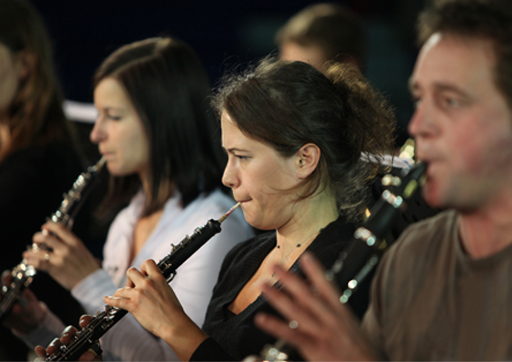2.2 Melodic colour in the orchestra
As instruments each have unique sound qualities, combining different instruments can also have a dramatic effect on musical timbre. A full orchestra combines a diverse range of instruments and tone colours, and the choice of instruments which sound the melody can have an impact on the character of the music.
Activity 9
Listen to the following extracts from Benjamin Britten’s Young Person’s Guide to the Orchestra. As you listen, try to jot down words which might describe the sound quality of the instrument combinations which support the melody at points in the piece.
Audio 20–23: Britten, Young Person’s Guide to the Orchestra
Discussion
In Audio 20, the bright, piercing sound of the legato oboe contrasted with the warmer sound of legato accompanying strings. The relaxed tempo of the music combined with these timbres might suggest a pastoral scene. Audio 21 had a military feel, combining trumpets and a snare drum. The bright yet warm tones of the trumpet contrasted with the hard, rattling sound of the snare drum. In Audio 22, the playful mellow tones of the clarinet, occasionally shrill in the higher registers, were accompanied by the deep tones of the tuba. This accompaniment had the feel of an ‘um-pah-pah’ which added to the sense of playfulness. Finally in Audio 23 the full orchestra sounded, but you may have been able to pick out the sounds of individual instruments or instrument families – the brittleness of the xylophone picking out parts of the melody with the legato violins, joined by the trumpet, and the warm tones of the brass holding longer notes.
When you listen to a piece of music, think about the combination of instruments used, and the effect of the individual instrument’s tone colour on the overall timbre. Give thought to how this characterises a melody and the music as a whole.
You may wish to return to the Philharmonia Instruments website [Tip: hold Ctrl and click a link to open it in a new tab. (Hide tip)] to listen to individual orchestral instruments to help you to identify instruments and think about their unique sound quality.

